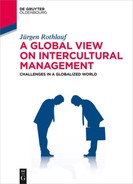Table of Contents
A Global View on Intercultural Management
Title Page
Copyright Page
Preface
Acknowledgments
Table of Figures
List of Tables
1 Globalization and InterculturalManagement
Title Page
Copyright Page
Preface
Acknowledgments
Table of Figures
List of Tables
1 Globalization and InterculturalManagement
1.2 Intercultural management
1.2.1 Definition of intercultural management
1.2.2 The importance of intercultural management
1.2.3 The tasks of intercultural management
1.2.4 Challenges in the field of intercultural management
1.2.5 The European Union and intercultural dialogue
1.2.6 Intercultural management vs. cross-cultural-management
1.2.2 The importance of intercultural management
1.2.3 The tasks of intercultural management
1.2.4 Challenges in the field of intercultural management
1.2.5 The European Union and intercultural dialogue
1.2.6 Intercultural management vs. cross-cultural-management
2Cultural Reflection as a Starting Point forIntercultural Management
2.0 Statement of the problem
2.1 Acting in a different cultural setting
2.2 The term “culture” from a scientific-anthropologicalpoint of view
2.3 The Iceberg-Model
2.4 Approaching a systematization of differentcultural concepts
2.1 Acting in a different cultural setting
2.2 The term “culture” from a scientific-anthropologicalpoint of view
2.3 The Iceberg-Model
2.4 Approaching a systematization of differentcultural concepts
3 Corporate Culture and Internationalization
3.2 Mergers & acquisitions
3.2.1 The terms “merger” & “acquisition”
3.2.2 Cross-border M&A
3.2.3 Reasons for M&A
3.2.4 Drawbacks
3.2.5 The process of forming M&A
3.2.6 Cultural Due Diligence
3.2.7 An evaluation of mergers & acquisitions
3.2.8 The influence of culture on M&A – selected results of two studies
3.2.9 A practical example: a pre-deal planning by KPMG
3.2.2 Cross-border M&A
3.2.3 Reasons for M&A
3.2.4 Drawbacks
3.2.5 The process of forming M&A
3.2.6 Cultural Due Diligence
3.2.7 An evaluation of mergers & acquisitions
3.2.8 The influence of culture on M&A – selected results of two studies
3.2.9 A practical example: a pre-deal planning by KPMG
4 Values under the Influence of Culture andTechnology
4.0 Statement of the problem
4.1 Values and responsibilities
4.2 De Bono’s Six Value Medals
4.3 The World Values Survey
4.1 Values and responsibilities
4.2 De Bono’s Six Value Medals
4.3 The World Values Survey
4.4 Valuing diversity and managing diversity
4.4.1 Definition of diversity
4.4.2 Diversity management
4.4.3 Diversity management within intercultural management
4.4.4 Theoretical approaches towards diversity management
4.4.5 The benefits, dangers and limitations of an active diversitymanagement
4.4.6 The drivers for implementing diversity management
4.4.7 The future development of diversity management
4.4.2 Diversity management
4.4.3 Diversity management within intercultural management
4.4.4 Theoretical approaches towards diversity management
4.4.5 The benefits, dangers and limitations of an active diversitymanagement
4.4.6 The drivers for implementing diversity management
4.4.7 The future development of diversity management
5 Intercultural Competence
5.2 Relevance of intercultural competence
5.3 Intercultural competence in the framework of the7-S-Model
5.3 Intercultural competence in the framework of the7-S-Model
6 Intercultural Communication
6.0 Statement of the problem
6.1 The importance of intercultural communication
6.2 The communication model
6.3 Negotiating across cultures
6.4 Levels of communication
6.5 Verbal communication
6.1 The importance of intercultural communication
6.2 The communication model
6.3 Negotiating across cultures
6.4 Levels of communication
6.5 Verbal communication
7 Leadership Across Cultures
7.3 Four types of leaders
7.4 The Lewis Model
7.5 Leading across cultures: personality versus authenticity
7.6 Leadership affected by religion
7.4 The Lewis Model
7.5 Leading across cultures: personality versus authenticity
7.6 Leadership affected by religion
8 Multicultural Teams
8.0 Statement of the problem
8.1 The necessity of multicultural teams
8.2 Challenges for multicultural teams
8.3 The multicultural learning process
8.4 Multiculturality and group formation
8.5 Multicultural team effectiveness
8.1 The necessity of multicultural teams
8.2 Challenges for multicultural teams
8.3 The multicultural learning process
8.4 Multiculturality and group formation
8.5 Multicultural team effectiveness
9 Intercultural Preparation and Reintegration
9.0 Statement of the problem
9.1 The role of expatriates
9.2 Intercultural learning and culture shock
9.1 The role of expatriates
9.2 Intercultural learning and culture shock
9.8 Reintegration
9.8.1 Definitions
9.8.2 The repatriation process
9.8.3 Major difficulties for employees
9.8.4 Personal and intercultural problems
9.8.5 Phases of reintegration
9.8.6 Theoretical reintegration model by Jassawalla, Connolly andSlojkowski
9.8.7 Consequences of insufficient reintegration
9.8.8 Repatriation planning
9.8.9 The employees’ view on reintegration
9.8.10 Repatriation checklist
9.8.2 The repatriation process
9.8.3 Major difficulties for employees
9.8.4 Personal and intercultural problems
9.8.5 Phases of reintegration
9.8.6 Theoretical reintegration model by Jassawalla, Connolly andSlojkowski
9.8.7 Consequences of insufficient reintegration
9.8.8 Repatriation planning
9.8.9 The employees’ view on reintegration
9.8.10 Repatriation checklist
..................Content has been hidden....................
You can't read the all page of ebook, please click here login for view all page.
